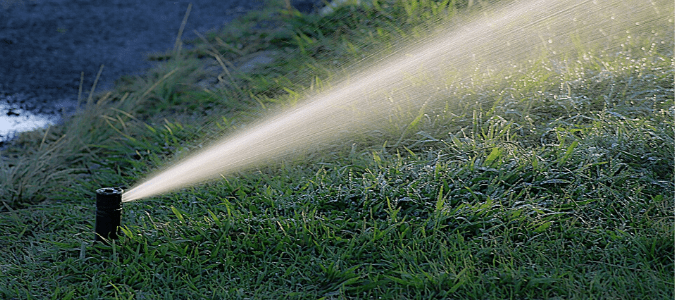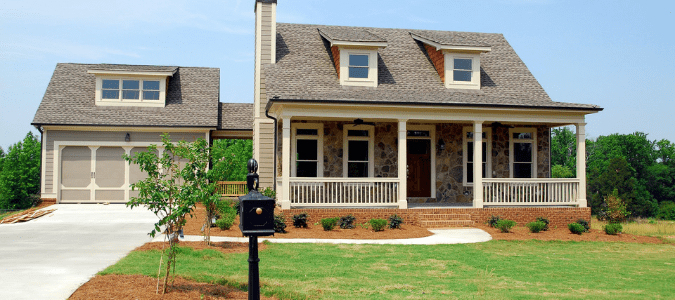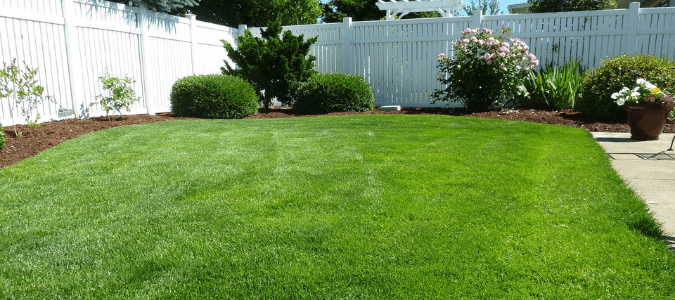
If you want a yard full of lush, beautiful grass, you need to supply plenty of what it needs most: water. Of course, that can be easier said than done, especially if you’ve ever turned on your yard’s irrigation system only to discover that your sprinkler heads are not popping up. So, what should you do when you encounter this problem?
While there are several different types of sprinkler systems, pop-up sprinklers are very common in residential areas because they lie flush to the ground a majority of the time, so they don’t detract from your lawn’s visual appeal. The top of the sprinkler has a nozzle coming from a piston that comes up when your system is on and retracts when not in use.
When you turn on the sprinklers and one or more sprinkler heads don’t pop up, the first possibility to consider is also one of the simplest to resolve on your own: Your sprinkler heads may be clogged with dirt and debris that is preventing them from functioning properly. If this is the case, all you need to do is turn on your sprinklers and then press the pop-up riser on the sprinkler head down with your foot so that it is pushed all the way back down into the body. Then, pull up to release the pop-up riser. Repeat this four to five times to loosen and flush out any debris that may be caught in the sprinkler head. You’ll need to keep in mind that you will get wet while doing this, so plan accordingly.
It’s also possible that your sprinkler heads are not popping up because there isn’t enough water pressure in the zone with the malfunctioning head. If one of the valves connected with your system is partially or completely closed, this can cause low pressure in the system. Fortunately, this is relatively easy to check, simply by looking at the valves—including the main shutoff valve as well as the valves on the backflow device, if there is one—and turning them counterclockwise to make sure they are open all the way.
A leak or break in your sprinkler’s water line can also cause low pressure in the system and make one or more heads fail to pop up. Signs of a leak or break somewhere in the water line might include unusually low, muddy or wet spots on your lawn that don’t disappear in dry weather; noticeably greener grass at one, seemingly random point in the lawn or an increase in your monthly water bill. If you start noticing consistently higher water bills, it’s possible that your sprinkler system has had an undetected leak or break for quite some time.
If you want to attempt a repair yourself, you might be able to find a sprinkler leak and make the fix, but keep in mind that it can be very difficult to find the exact spot where the cracked or broken water line is, since most of your irrigation system is buried underground. Once you have found the right spot, you’ll have to dig out the area—carefully, to avoid making the problem worse—until you’ve exposed the broken portion of pipe. Then use a hand saw to cut out the broken section and replace it with new PVC pipe, fitted with couplers on both ends and glued into place.
Cracked or broken sprinkler heads might also fail to pop up. If this is the problem, they might seep water even when the sprinklers are turned off. Cracked or broken heads generally can’t be repaired, and instead need to be replaced. Other possible causes of sprinkler heads not popping up include new construction in the area, which places increased demand on the water system as it serves more homes or buildings, which might divert water from your home, or an issue with the municipal water supply. In either of these cases, your property would probably not be the only one experiencing water issues; your neighbors would be as well, and a call to your water company would be in order.
Whatever type of problem you may be facing with your irrigation system, it’s important to get the job done correctly. Lawns that are not properly watered are not only an eyesore, but they are also at risk of further problems, such as yard fungus and other conditions.
If you have checked your stations and done other checks and your sprinkler heads still won’t pop up, you’ll probably need to get in touch with a licensed irrigation specialist who can determine the cause of the problem and make needed repairs to your irrigation system.
In this post, we will go into more detail about common problems homeowners have with their sprinklers, including low water pressure and leaks. While these issued are typically best handled by a professional, there are a few things some homeowners can try on their own while help is on the way.

How to Increase Water Pressure for Sprinkler System
The first thing to think about if you have low water pressure in your sprinkler system is how long the system has been malfunctioning. If it has never worked correctly, the problem may be in the design of the system itself, which might best be addressed by having the system completely overhauled by a professional. If you have recently added on to your irrigation system and there are now more sprinkler heads in an area, the zone may need more water than what it is currently receiving, leading to lower water pressure.
If the problem is new and is not due to an addition to your sprinkler system, it’s likely that some part of the system isn’t functioning properly and needs to be cleaned, repaired or replaced. If you want to try to increase your sprinkler system’s water pressure on your own, there are a couple of basic ways to troubleshoot the problem.
First, check the valves associated with your sprinkler system to make sure they are fully open and that there are no leaks. The first valve you’ll want to check is your pressure vacuum breaker valve which is typically located outside of your house and above your sprinkler control box. If this valve is stuck in a partially closed position, turn the valve to increase the flow of water to your system. If this valve is already open, you’ll want to check inside your sprinkler control valve box. Make sure that your sprinkler solenoid valves are not partially closed, and that all wiring and fittings are intact.
If your valves are open and working, look for indications that there may be a broken or leaking pipe or connection somewhere along the line of the sprinkler system. This might be the culprit if you notice persistently soggy spots in the grass, unusually green spots in the grass or a water meter that indicates water is running even when you’ve turned off all faucets, hose bibs and other water-consuming elements of your property, including the sprinkler system.
If you believe there is a leak somewhere in your sprinkler system, locating it and fixing the issue should increase the water pressure.

How to Find a Leak in a Sprinkler System
The truth is, finding a leak in a sprinkler system is a tricky process. It can be very difficult to locate the exact spot where a leak is occurring, since most sprinkler systems are underground. Sometimes, it’s not obvious where the leak in the system is until it’s been leaking for quite some time. When the sprinkler system has been leaking for some time, you may start to notice softer, muddier, low-lying spots in the turf, and potentially the presence of mealybugs. You might also see significantly greener patches of grass because these areas have constant access to water rather than only when the sprinklers are turned on, like the rest of the lawn. You might also notice higher water bills than usual.
A good tool to diagnose a water leak somewhere on your property is your water meter—the apparatus, usually located in your front yard somewhere near the street, that your local meter reader uses each month to determine your property’s monthly water usage and bill. Homeowners can use this meter to confirm the presence of a leak by first turning off every water line in and around the home. This includes shutting off the water to all faucets, toilets, clothes washers and dishwashers indoors, as well as the sprinklers and hose bibs outdoors, along with any other water-consuming systems or appliances that may be located in or around the home.
Once everything has been shut off, go to the water meter and lift off the cover. Keep in mind, these covers are made of metal and can be quite heavy; you might need to use a screwdriver, a pair of pliers or a water meter key to safely remove the cover. The meter inside will likely be equipped with both a numeric dial as well as a dial with a sweep-hand. The sweep-hand should be still when all the water to the home is shut off. If it’s still moving, this indicates a leak somewhere on the property.
Once you’ve determined that there is, indeed, a leak in the sprinkler system, it’s time to pinpoint where it might be. Look for spots in your yard along the water lines of your sprinkler system that are noticeably greener than other areas, indicating that these areas might be receiving extra water. Another possible indicator of a leak is patches in the yard along the water lines that are lower and wetter or muddier than other areas. You might also poke gently into the turf with a screwdriver to see if the ground feels softer in certain areas than others.
Handy homeowners might be able to find and repair a leak in the sprinkler system by carefully digging out the turf and dirt around the broken pipe, cutting out the broken section and replacing it with a new pipe and couplers. Many homeowners, on the other hand, prefer to contact a licensed irrigation specialist to handle the job, to ensure that all leaks are identified and the sprinkler system repair is done quickly, properly and thoroughly.
Experts in sprinkler repairs can save homeowners money over time, since a working sprinkler system that is well maintained will decrease water usage while supporting a lush and thriving yard. Irrigation specialists will recommend annual inspections of the sprinkler system. During these visits, the spray of your sprinklers can be adjusted and checked for dirt and other debris. Regular sprinkler system maintenance and inspections will ensure that everything continues to function properly over time, and issues that are found can be fixed before they develop into major problems.
ABC Can Care For Your Sprinklers
Sprinklers that aren’t working correctly can quickly lead to a variety of problems. Whether your lawn is dying or your water bills have skyrocketed, you can count on ABC Home & Commercial Services to quickly determine the cause of the problem and perform any needed repairs to your sprinklers. Our team is comprised of licensed irrigation specialists, so you can feel confident that we’ll get your sprinkler system working in optimal condition. You can trust us to know how to keep your lawn green all summer long.